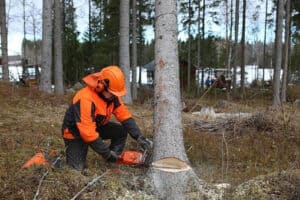Workers’ Compensation in the Logging & Sawmill Industries
 Logging and sawmill operations are among the most dangerous occupations of any industry in the country.
Logging and sawmill operations are among the most dangerous occupations of any industry in the country.
- Because of this, workers’ comp insurance is both expensive and difficult to obtain.
- Physical hazardsof logging include:
- Rough terrain
- Heavy equipment
- Saws
- Unstable heavy logs
- All of which results in a high frequency of severe injuries.
Due to the heavy labor with numerous physical hazards, safety of the loggers is a challenge.
- An unsafe act by one logger can result in injury or death to others or themselves.
- The logging companies that stay in business are the ones that constantly promote safety.
Logging and sawmill operations are concentrated in the Appalachian region of the eastern United States and the mountain regions of the west and northwestern portion of the country.
- Most logging operations and sawmills tend to be small businesses
- There are a few national corporations who own hundreds of square miles of timberland
When injuries occur to loggers, immediate medical treatment is often not readily available due to the remote locations.
- In the states where the employer can select the medical provider, the number of choices may be limited due to the low number and location of medical providers
- Most states limit the distance an employee can be required to travel for medical care.
- While loggers do not earn high incomes, total indemnity benefits paid on work comp claims for loggers are higher than most occupations due to the severity of injuries that accompany the accidents.
- Impairment ratings are common resulting in permanent partial disability payments.
- When loggers incur a disability that prevents them from returning to work as a logger, vocational rehabilitation is often difficult to accomplish due to a lack of transferable skills.
Logging covers more than the harvesting of trees. Some of the sub-categories of logging that would have the same or similar work comp issues (but less risk and comparatively lower rates) include:
- Log hauling
- Shake and shingle mills (automated)
- Pulp and paper manufacturing
- Log home manufacturing
- Plywood manufacturing
- Wood products manufacturing
- Tree farms
Transitional / Modified Duties in the Logging / Sawmill Industry
Logging and Sawmills are considered very hazardous and job accommodation is challenging. The jobs, Fallers, Choke Setters, Equipment and Tractor Operators are all physically demanding. Placement with a non-profit agency is an ideal alternative in this industry to keep an employee engaged and productive versus being at home focused on an injury and disability.
If there is an applicable union contract, be sure to review the terms to verify modified duty is not prohibited or restricted. Other possible accommodations include:
| Logging & Sawmill Workers: | Consider temporary placement in the office taking orders or completing a project that’s been on the “back burner” such as filing, data entry or shredding. |
| Manufacturing Worker: | Identify tasks and lines in the plant with physical requirements within the physician assigned abilities. |



 Longshoremen & Harbor Workers
Longshoremen & Harbor Workers